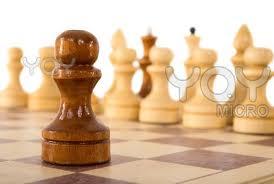
The Pawn Storm
It’s generally considered advisable to cover your king behind a row of pawns, such as the following:
Or this:
How does one go about attacking such a castled position? A solid barricade of pawns prevents the pieces from coming into direct contact with the black king. There is the chance to sneak around back (in the form of a back-rank mate). But this usually takes the form of a momentary tactical chance, and can often be solved simply by pushing one of the pawns, giving the king some luft.
There are two methods of breaking down the pawn position around the king: 1. A piece sacrifice that removes the pawns and 2. A pawn storm. In this article we will focus on the pawn storm.
When you use a pawn storm to attack your opponent, there are a couple of goals. First of all, you want to remove your opponent’s pawns. This is pretty obvious. But an equally important goal is to remove your own pawns. This is because you need open lines to use your rooks and/or queen to attack the opponent. And finally, sometimes the pawns themselves can become agents in the attack, by supporting important squares or even promoting to a queen.
Here is a very elementary example of a pawn storm:
In this excerpt from a game, White’s pawn storm did all three things described above. In such a position, attempting a piece attack on the black kingside would not have worked. But a pawn storm was very effective.
There are several factors affecting the success of a pawn storm. First of all, there should be some possibility of opening lines by the storm. Second, you need to have the center under a reasonable amount of control. If you don’t have enough control in the center, the time used and weaknesses created by pushing pawns on the flank will come back to haunt you. Your opponent could make a central break which would ordinarily not work, but suddenly becomes strong simply by virtue of switching the battlefield. Such as in the following example:
It is very helpful – for the success of your pawn storm – if your opponent has pushed one of his pawns in front of his castled position. For example, in the following position:
Black can very quickly open lines with ...b5-b4, since that pawn comes into contact immediately with the a3 pawn. White will have to either capture on b4, resulting in an open a-file (which will be quite deadly); or ignore the ...b4 move, which would allow Black to capture on a3, with equally disastrous consequences. Compare it to this position:
Here Black can play ...b4, but it won’t come into contact with any enemy pawns yet. To really open lines, Black will have to continue with ...a4 and ...b3. And still it won’t be so easy to break through, since White might be able to ignore the pawn and then hide behind it when it captures on a2. Ivanchuk uses this defensive method in the following example, where he uses typical and instructive methods to keep the kingside closed long enough for his own pawn storm to reach its goals.
Here is another method of restraining a pawn storm:
In conclusion, while a pawn storm doesn’t cause power outages or gas shortages, it can blow away your kingside pawns and open lines!






